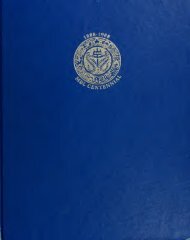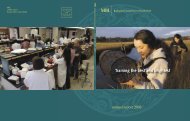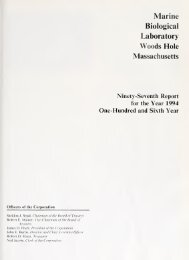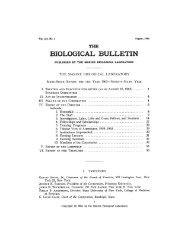View/Open - HPS Repository
View/Open - HPS Repository
View/Open - HPS Repository
Create successful ePaper yourself
Turn your PDF publications into a flip-book with our unique Google optimized e-Paper software.
guide, in which all the different techniques in use in the various schools would<br />
have been described objectively. The present survey is unfortunately not complete.<br />
The very recent, but promising micro motion picture technique is not<br />
included. The literature survey at the end of the book does not seem entirely<br />
up to date, particularly as regards the foreign literature.<br />
The author has tried to show the fundamental significance of the tissue<br />
culture method as well as its applicability to biochemistry, pharmacology,<br />
bacteriology, pathology, radiology, etc., so that the book probably will find<br />
many readers in various branches of science.<br />
P. D. NIEUWKOOP<br />
"THE PHYSIOLOGY OF INSECT METAMORPHOSIS"<br />
1954<br />
by V. B. Wigglesworth "Cambridge monographs in<br />
152 pp. with 45 figs and 4 pis Experimental Biology" No. 1<br />
Cambridge University Press<br />
Price: 12 s. 6 d.<br />
The reason why this book is of great importance also for the general embryologist<br />
is the fact that, speciaUzed as the subject may be, it is discussed<br />
against the broadest possible biological background. The central theme is the<br />
view expressed by the author that metamorphosis is merely a special case of<br />
the general phenomenon of polymorphism. This view is particularly supported<br />
by the choice of the author's experimental animal, Rhodnius, which has no<br />
imaginal discs in the strict sense of the word. All imaginal structures are<br />
formed by tissues which have previously formed specialized larval structures,<br />
so that it is clear that these tissues have both larval and adult potencies from<br />
the beginning.<br />
Because Rhodnius is always put in the centre, the book is not so much a<br />
compilation of the work done in this field, but rather a personal account of the<br />
author's own work and thought, with full and critical use of the work of others.<br />
The title of the book is perhaps a little misleading, since much attention has<br />
also been given to larval growth and moulting and their physiological control,<br />
subjects which cannot be excluded for a good understanding of metamorphosis.<br />
The theoretical considerations given to such notions as polymorphism, integration,<br />
competence, determination and differentiation, as well as the emphasis<br />
put upon the role of the substrate on which organizing substances (i.e. hormones)<br />
act, are of great. general importance.<br />
An extensive biblography and a subject index are given. The typography<br />
and the execution of the numerous beautiful illustrations are excellent. If the<br />
following numbers of this series keep up the standards set here, we may congratulate<br />
the publishers on their initiative.<br />
J. FABER<br />
"ANALYSIS OF DEVELOPMENT"<br />
1955<br />
by B. H. Willier, P. A. Weiss and W. B. Saunders Company,<br />
V. Hamburger<br />
Philadelphia 6 London<br />
735 pp. with 248 figs Price: ?<br />
This composite work, to which 28 American scientists contributed, will form<br />
199
















